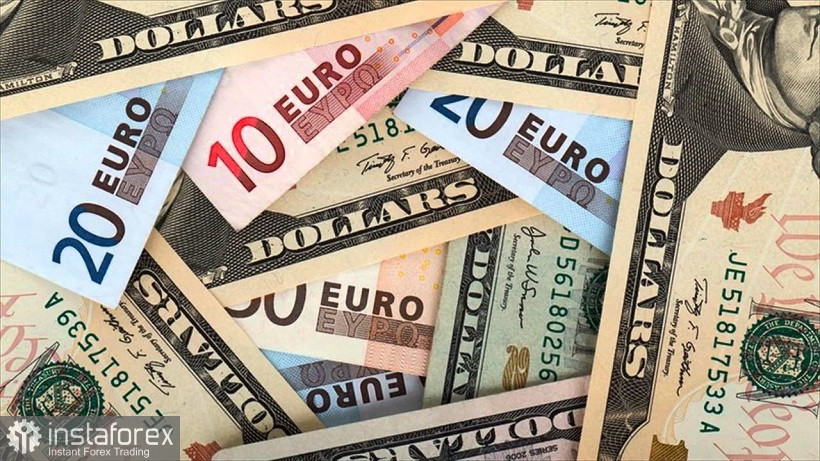The euro-dollar pair ended the trading week at 1.0545, that is, in the area of five-year lows. On Friday, EUR/USD bulls were able to "pull" the pair out of the fourth figure, but they still failed to organize a large-scale corrective rollback. The downward trend is still in force, and it is due to several fundamental factors. The pair is actively decreasing both due to the strengthening of the dollar and due to the weakening of the euro.

Today is the last day of April, so you can sum up not only the week, but also the month. Over the past four weeks, the EUR/USD pair has fallen by almost 600 points. This is perhaps the sharpest rate of decline since the spring of 2020, when the dollar significantly strengthened its position in the wake of the coronavirus crisis. Today, the greenback is strengthening due to the hawkish position of the Federal Reserve and the growth of anti-risk sentiment in the foreign exchange market.
The weakness of the euro (due to the risks of stagflation and the indecisiveness of the European Central Bank) allows the EUR/USD bears to overcome price boundaries almost unhindered. Bears, without any problems, impulsively pushed through rather powerful support levels, which previously held back the onslaught of dollar bulls. For example, the mark of 1.0900 for many weeks (from February to the end of March) did not allow the EUR/USD bears to go to the area of 8-7 figures. And as soon as the bears nevertheless conquered this boundary, traders discovered new price horizons for themselves, eventually reaching the 4th figure.
Now market participants are near another powerful price barrier. We are talking about a 20-year price low at around 1.0350. On the one hand, there are 200 more points to this mark if we count from Friday's closing price. On the other hand, the EUR/USD bears were already actively testing the 4th figure last week, appearing at 1.0470. And here again we can recall the pace of the April decline, which made it possible to break through the seemingly "impenetrable" support levels.
Therefore, it is possible to speak about the possible reaching of the level of 1.0350 not in a hypothetical, but quite in a practical way. For example, if the Fed at the May meeting (the results of which will be announced on Wednesday) hints at several rounds of 50-point rate hikes, or unexpectedly raises the rate by 75 points at once. The latter option is, of course, unlikely, but it cannot be ruled out either. In addition, the central bank may put forward a 75-point rate hike for the foreseeable future (i.e. at the June or July meeting). And this will be quite enough for the dollar bulls to again organize a rally throughout the market. Reaching 1.0350 in this context will only be a matter of time.
In other words, the EUR/USD bears have a very real 200 point price gap to the main and most powerful support level. In my opinion, bears will not be able to "swoop" to push through 20-year price lows, opening the way to parity. Therefore, in the middle of the 3rd figure, you will need to be especially careful not to "catch the price low".
It is advisable to open short positions with the current corrective rollback. On Friday, EUR/USD bulls organized a counterattack due to two fundamental factors.
First, European inflation is back in the green zone – this is especially true of the core consumer price index (which jumped to 3.5%). However, this release will not be able to change the general state of affairs. The ECB is still taking a rather cautious stance, despite the timid calls of some members of the ECB to raise interest rates in July. Compared to the resolutely resolute Fed, the ECB looks quite faded. And another inflationary spurt in the eurozone will not reverse the current situation.
The second reason for the EUR/USD's upward corrective pullback is the announcement of the Fed's most preferred measure of inflation, the Personal Consumption Expenditure (PCE) index. It rose to 5.2% (in annual terms), while most experts predicted growth to 5.3%. That is, the report was in the red zone. However, this is also a rather dubious reason for a correction in EUR/USD, since the most important indicator for the Fed still remains at the level of 39-year highs. The indicator has been consistently and steadily increasing for six months, and only slowed down its growth in March, and minimally. For comparison, it can be noted that at the beginning of last year, PCE fluctuated in the range of 1.4% -1.9%, but then it began to gradually gain momentum, and especially actively - over the last six months. The April release was a logical addition to another inflation report, which reflected a record rise in the consumer price index.
Thus, the euro-dollar pair has every reason for its further decline, especially ahead of the Fed's May meeting. It is advisable to use Friday's corrective rollback to open short positions with the main medium-term targets of 1.0500 and 1.0470.
 English
English 
 Русский
Русский Bahasa Indonesia
Bahasa Indonesia Bahasa Malay
Bahasa Malay ไทย
ไทย Español
Español Deutsch
Deutsch Български
Български Français
Français Tiếng Việt
Tiếng Việt 中文
中文 বাংলা
বাংলা हिन्दी
हिन्दी Čeština
Čeština Українська
Українська Română
Română

